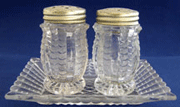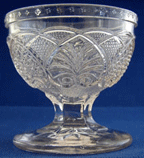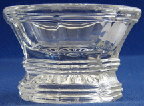
 |
| When you think about the possibility of having no salt available to make food taste better, it should come as no surprise that the use of salt on the table is one of the earliest refinements of civilization. For centuries, man has fashioned vessels to hold it using many materials including wood, pottery, pewter and, of course, glass. Because salt was so necessary for eating and preserving food it was very costly in olden times. It is obvious that a great deal of thought was put into creating suitable containers for it. According to Brown's book on salt dishes, in the early period in inland sections of the country, salt had to be procured from abroad, from the sea coast or where salty incrustations are found on the surface. In the term "salt cellars" the word "salt" is superfluous because the Latin word "salarius" means salt holder. The larger 'master' salt dishes were presumably used by the heads of households while others got a smaller, 'individual' size. These 'open' salt dishes were used with a small spoon of wood or metal. It was late in the nineteenth century before the long experiment to get salt to flow freely permitting the every day use of salt shakers. So with a few exceptions, EAPG patterns up until the 1880s came with open salts but patterns made late in the 1880s and later were made in shakers. |
This is our Salt Store Front.
Please click on the pictures or words below to
go to a page that will show the types of salt dishes you wish to see.
To learn how easy it is to purchase from PatternGlass.com, click HERE.
Shipping is extra and minimal for these little pieces.
 |
 |
 |
 |
 |
|
 |
 |
 |